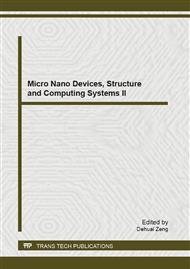p.113
p.119
p.125
p.130
p.136
p.145
p.149
p.153
p.157
Constrained Structural Optimization of Electro-Thermal Microactuator Using Double Chromosome Genetic Evolution
Abstract:
This paper presents two design optimization models for U-type electro-thermal microactuator. The result shows that the unequal arm model has better performance than the equal arm model. The models were solved by finite element analysis that are verified and comparison to publish paper and then are utilized in optimum design. The feature of presenting work contains temperature constraints to avoid the harm of operating object and decrease stress concentration on flexure. For handling design constraints, a method named double chromosome genetic evolution (DCGE) is developed in gene based algorithm. The idea of the presenting constrained strategy was inspired from the gene evolved by double helix chromosome of expressing certain traits. The constrained evolutionary algorithm proposed in this work is efficient and reliable. It can be integrated into a broad field of engineering optimization.
Info:
Periodical:
Pages:
136-141
Citation:
Online since:
March 2013
Authors:
Price:
Сopyright:
© 2013 Trans Tech Publications Ltd. All Rights Reserved
Share:
Citation:


